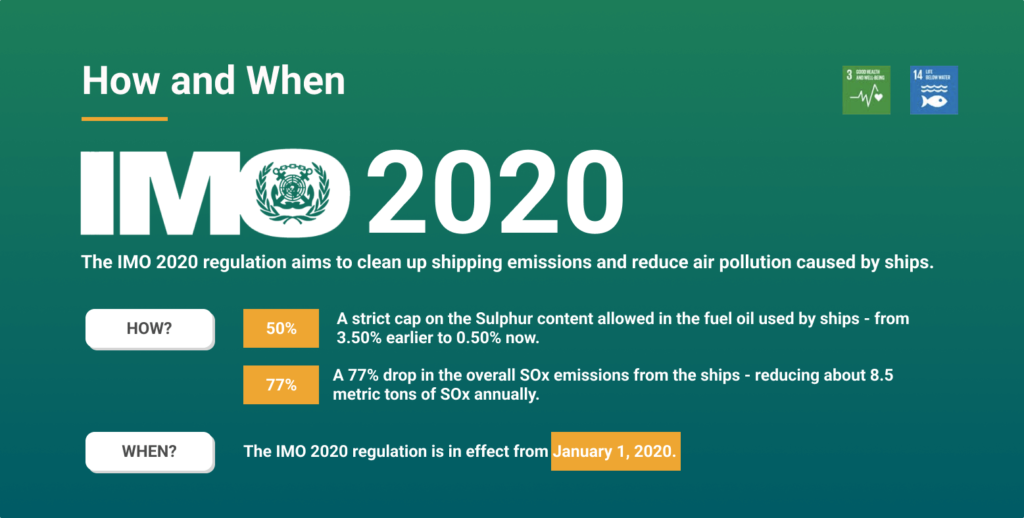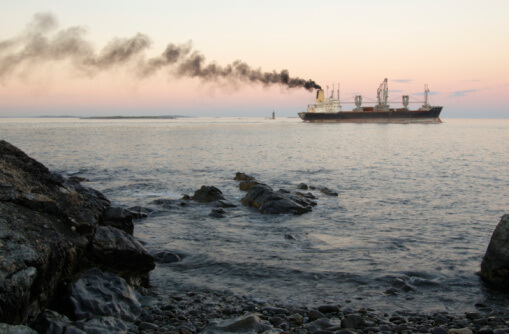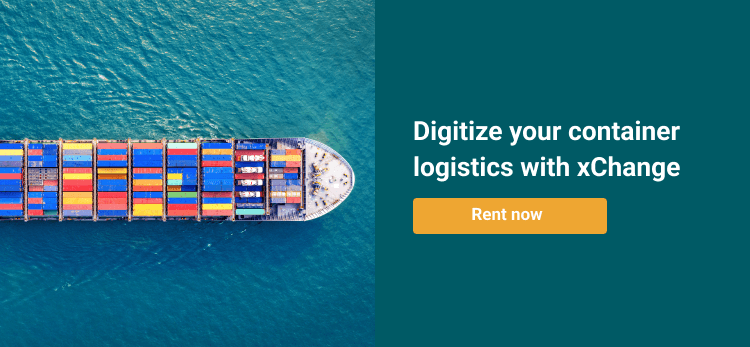The new IMO 2020 regulation will have major effects on the shipping industry. This blog will take you through everything you need to know about it and prepare for the changes. Read on!
The new IMO 2020 regulation is here. And it’s going to impact not just your business but the whole shipping industry. The new regulation is all set to put a cap on the pollution caused by the shipping industry. The goal is to make maritime logistics more ecologically sustainable. That is good in the long run. But, there’s more that will precede before the impacts of the regulation play out.
A transition like this will mean changing existing practices in the industry. The impact of such a change will be felt through supply chains globally. That’s why it’s crucial that you know about the IMO 2020 regulation and what it entails for you.
In this article, we’ll give you a full overview of the IMO 2020 regulation. We’ll discuss its impacts and what your options are to deal with them. We’ll also look at how Container xChange’s online container leasing platform can help you during this change.
But, are you are already curious about what xChange has to offer? We’ve got you. Our container leasing platform connects container users with leasing companies. The platform can help you meet your container needs easily. And, at prices you want to pay. Just put in your details below and discover how easy and cost-effective container renting with xChange is. 👇
IMO 2020 regulation – What, why, and how
On Day One of the Intermodal Europe 2019, the marquee event that brings together the container transport and container logistics sectors, in Hamburg, Germany, Stefan Verberckmoes of Alphaliner gave an insightful presentation on the effects the IMO 2020 Global Sulphur Cap will soon have on liner shipping. Verberckmoes is an editor and analyst for Alphaliner, a leading online provider of information and in-depth analysis for the liner shipping industry.
The IMO 2020 regulation is a directive from the International Maritime Organization, the specialized agency of the United Nations that regulates shipping. IMO’s new global policy aims to protect public health and support the environment. According to the regulation, starting on the 1st of January 2020, all the seagoing vessels must reduce their Sulphur oxide gas emissions.
In his presentation, Verberckmoes also discussed the 3 main options vessel owners can choose from to comply with the IMO 2020 regulations. But before we move to the solutions, let’s take a quick look at the IMO 2020 regulation in detail.
How significant is the reduction in Sulphur oxides emissions?
Once the IMO 2020 regulation goes into effect, all seagoing vessels must reduce Sulphur oxide gas emissions by 85%. The maximum Sulphur content of marine fuels which vessels can use will be limited to 0.5% from the current 3.5%. For the dedicated Environmental Control Areas (ECA) in parts of Northern Europe, North America and Asia, the fuel must be further reduced to a 0.01% Sulphur content.
What are the impacts of the new limit on human health?
The new IMO 2020 regulation will ensure that the fuels used in ships and liners are of high quality and have low emission rates. The aim is to reduce the Sulphur oxide emission rate of ships and liners by 77%. That’s an annual reduction of approximately 8.5 million metric tons of these harmful pollutants.
This will help in controlling the health impacts of air pollution such as premature deaths, cardiovascular, respiratory, and pulmonary diseases. The IMO 2020 regulation will have huge positive impacts on human health in the world.
What must ships do to comply with the new IMO regulations?
The IMO 2020 regulation will affect vessel operators, refineries, and global oil markets. At present, there’re 3 viable options to choose from to comply with the Sulphur limits set by the regulation. They are:
(1) the installation of scrubbers
(2) the usage of LNG
(3) switching to Very Low Sulphur Fuel Oil (VLSFO)
Sections later in the blog explain each of these technologies and compare them based on their limitations and/or disadvantages to vessel operators.

What is IMO doing to ensure compliance with the 0.50% limit?
Subject to the jurisdiction, there are penalties for not complying with the shipping emission limits set by the IMO 2020 regulation. These include high fines, ship arrest, or even imprisonment of the captain.
Are new fuels being used to meet the 2020 limit?
Yes. To meet the 2020 limit IMO has allowed the use of on-petroleum-based fuels like clean gas LNG, Very Low Sulphur Fuel (VLSF), or MGO.

Key changes to expect post IMO 2020 regulation
The IMO 2020 regulation will bring about a lot of positive impacts in the direction of sustainable shipping. Here they are:
Cleaner Air
The shipping industry is a big contributor to air pollution. The IMO 2020 regulation is aiming to make dramatic cuts in Sulphur oxides emission from vessels. This will directly lead to the shipping industry becoming sustainable and eco-friendly.
Human Health
Air pollution is extremely dangerous to human health. The IMO 2020 regulations aim to improve the air quality and thereby improve the quality of human life globally.
High-quality Fuels
The usage of high-quality fuels is the aim under the IMO 2020 regulation. This will provide shipowners and shipping companies with sustainable options. These fuels have low emission rates and are not harmful to the environment.
Industry Guidance
The IMO 2020 regulation and its stakeholders are working to enhance the preparedness of the industry. They have released all the guidance required for the same. The transition will be monitored carefully, and everyone involved will have proper guidance.
Compliance Control
The IMO 2020 regulation also lays down guidance control rules. The Port State Control of the respective states will be responsible for controlling the vessels. The vessels will be inspected by checking logbooks, using sniffer devices, and sniffer drones.
Definitely, there are great positive impacts that the IMO 2020 regulation will bring about. But, with that, there are also some problems that will come about in the industry for a while such as cost surges and delays that can lead to container shortages in locations. We will get into the details of these problems in the upcoming section.
But worry not. The problems will not last forever and xChange can help you work through them!
With Container xChange, ship owners, freight forwarders, and container users can find containers with ease even during industry-wide transitions such as the IMO 2020 regulation. To see how xChange can help you, click on the banner below.

Complying with IMO 2020 regulation – What vessel operators can do
Open the section by underlining the importance of IMO 2020 and then move to discuss the need to adapt for vessel operators. Discuss the alternatives given below and their advantages versus their disadvantages.
Installing scrubbers
Scrubbers are exhaust gas cleaning systems that remove pollutants from the ship’s exhaust, allowing them to continue using higher-Sulphur fuels. This is done by pumping water through the engine’s funnel, so the Sulphur and other particles are “washed out”. There are two basic types of scrubbers; one that works in an open system by pumping seawater through the funnel of the vessel, and two, that works in a closed system and keep the “washout” on board the ship. “About 2,000 to 2,500 installations will be completed by the end of the year”, said Donald Gregory, director of the Exhaust Gas Cleaning Systems Association (EGCS). Out of that amount, 10% will be retrofitted on cruise ships. Further, at least 200 large container vessels are predicted to become equipped with Scrubbers in the coming months.
Downsides of installing scrubbers:
The process of installing scrubbers is limited and expensive due to space and capacity constraints and will inevitably increase operating costs. Another consideration is that the price and availability of higher Sulphur fuels after 2020 are uncertain.
Furthermore, scrubbers are a non-proven interims technology. The impact of scrubbers on the environment, ports, and coastal waters is debated with controversy. There are big issues concerning the subsequent handling and disposal of the washing water that contains the particles. Due to the size and power of the main engines of larger container vessels, the handling of the washout may vary. Several countries, including Singapore and China, have established strict rules for the use of the Open Loop scrubbers and for the treatment of the washed product as toxic waste, making the use of this technology even more expensive. Furthermore, they have banned Open-Loop scrubbers in inland port waters and coastal shipping ECAs since the environmental effects are questionable.
Switching to non-petroleum-based fuels
Vessel operators can switch to non-petroleum-based fuels, such as Liquefied Natural Gas (LNG) for propulsion. This is feasible for newer vessels with compatible specifications. Current knowledge indicates that the use of Liquefied Natural Gas (LNG) is preferable against scrubbers for Sulphur reduction.
Downsides of switching to non-petroleum-based fuels:
The infrastructure to support the use of LNG is currently limited in scope and availability.
Switching to a Very Low Sulphur Fuel (VLSF) or MGO
Vessel operators can switch to a Very Low Sulphur Fuel (VLSF) or MGO that complies with the new rules. This will be the most likely choice.
Downsides of switching to a Very Low Sulphur Fuel (VLSF) or MGO:
The cost, widespread availability, and specifications of new fuel for use in marine engines are still uncertain. The petroleum industry needs to adapt refineries and supply chains and is highly likely to pass these costs on to the market.
Adapting to IMO 2020 regulation
After weighing the options, the majority of carriers will use VLSF / MGO to meet legal requirements. While LNG technology is still in its early stages, scrubbers serve as a second temporary solution. Alphaliner has revealed a strong increase in Scrubber’s installation since June 2019. They report that 153 ships were equipped with a Scrubber at the end of October, and this number is expected to increase to 260 vessels by the 1st of January, 2020. This represents a total capacity of 2.3 MTEU, which is about 10% of the total container fleet capacity. Experts predict that by 2020 approximately 250-500 vessels, or a maximum of 10-12% of the global container fleet, will either be equipped with pollution cleaning technology (Scrubbers) or will be able to burn LNG.

Impacts of IMO 2020 regulation – What vessel operators should expect
Now, with an industry-wide change of such size and scope, sudden disruptions are to be expected. It will take time before things can become smooth and predictable. The aim is to make sure that all the ship owners, shipping companies, and freight forwarders are prepared. Here are the two main changes that you can expect in the shipping industry post the IMO 2020 regulation comes into effect.
Increase in freight rates
The inevitable increase in costs is expected to have a significant impact. The overall prices of container transportation and freight rates are expected to increase before the end of 2019. Consequently, long-term agreements for both full and part load containers will include a Bunker Adjustment Factor (BAF) – a price adjustment method.
“While it’s too early to see an impact on the freight market now because most of the work is yet to be done, rates are nonetheless likely to rise when the installations ramp up and vessels go off-hire,” said Jonathan Chappell, an analyst focusing on marine transportation equities at Evercore ISI.
Furthermore, there is a risk that by 1 January 2020 there won’t be enough IMO 2020 compliant fuels available in the geographical areas where the fuel is demanded. This shortage will further increase prices, temporarily at the very least.
Delays
Another key consideration is the quality control surrounding this new fuel. If the blending process of fuels is blended substandard, sediment will form and possibly lead to a breakdown of the main engine. Therefore, the fuel must meet a high degree of quality and compliance standards. Hence, transport services may be disrupted due to substandard fuel quality or insufficient availability of compliant bunker fuels when IMO 2020 commences.
Schedule delays may occur due to the aforementioned lack of availability or due to slower steaming to recover the costs for the more expensive IMO 2020 compliant fuel. If the tonnage has to be reduced for technical changes, for example, the installation of a scrubber, there will be a minor impact on available transport capacity as well.
A surge in costs and delays can have big effects on the shipping industry. It can hamper container movement across the globe. The only way to tackle the situation is to be prepared. And xChange can help you with that.
With xChange, you get a neutral platform that brings together container users and leasing companies. It makes container transactions throughout the industry smooth, cost-effective, safe, and easy. Click on the banner below to find out more.
Last comments on the IMO 2020 regulation
To sum up, we can expect that the beginning of this transition will be a bit messy. There are no cheap or free alternatives when it comes to achieving compliance with the 2020 Sulphur cap. Scrubbers, however, do seem to be the favoured option for large ships. We can assume freight rates will increase overall, though exact price increases still can’t be forecasted at this point.
To save on shipping, freight forwarders should consider the use of SOC containers. While freight rates go up, savings can be made on demurrage and detention. They can also increase flexibility as well as get pick-up credits. And to maximize fuel efficiency, avoiding empty container repositioning is vital.
And, when it comes to empty container repositioning, xChange is what you will need. It can help you adapt to the IMO 2020 regulation and the changes that it brings about in the industry. To check out our leasing platform and learn more click on the banner below.





